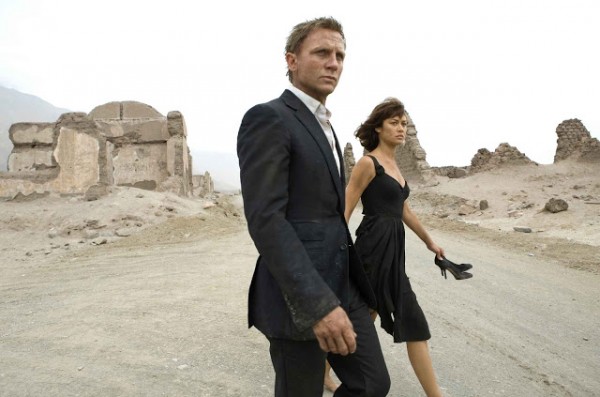 Am I the only one who noticed how good it is for 007 to have real friends?
Am I the only one who noticed how good it is for 007 to have real friends?
I’m half-playing here, but only by half, because a subtext of QOS is friendships and teammates. Witness the dialogue, including (and I’m quoting for memory so bear with me):
M to Bond: Knowing who your friends are is everything…
Camille and Bond: Friend of yours? I don’t have any friends…
Bond to Colonel of Police: You and I have a mutual friend!
Bond to Corinne Venneau: I have one that is similar, it belonged to a friend.
There are several other friend comments, another half-dozen or near so including Mathis also, and everyone works onscreen in two-man friendly teams: Bond and (surprise in the boot) Mr. White flee baddies; M and Tanner, Bond and Felix, Bond and Fields, Bond and Camille, Felix and Beem, Bond and M, Greene and Medrano, etc. Bond is alone onscreen quite rarely, in fact, although he is welcomed as the moving center of the film, whereas in GoldenEye we abandon our hero to spend many minutes in Severnaya.
Still not convinced to “see double” in the 2nd CR half film? Note how the ending camera angles, scenario and body positions at the end of QOS mirror the opening of CR!
Need I mention the pairings of CIA and MI-6, the PM and Foreign Minister, Foreign Minister and M, oil and water (not mixing), oil and diamonds, White and Greene, Greene and Elvis, Quantum and Le Chiffre, two conversations (both subtitled to draw attention) in the taxi, two hotels “booked” by two teachers on sabbatical, etc.? Next a look at the two films partnering each other…
Although the timings like the geologist’s assassin seem coincidental, the implied backstory and intricate plotting provides a real perspective on a Bond investigation.
The film’s sudden action highlights the danger Bond moves through always, and the reveals on plot are supposed to make us feel we are tracking with Bond as he unearths the bad guy’s doings.
Greene admittedly is not the usual father figure who tells “my dear boy” how brilliant his plan is before torturing him; but the way in which Bond extracts the Tierra Project is both heroic (he is rescuing the Bolivian people) and significant (he is seeking vengeance plus fulfilling his job role ala License To Kill).
One of the many attractive subplots or contexts of QOS is in Bond’s work–M accuses Bond of not being dispassionate but he is exactly that-calculating, hard and very deadly to his enemies. Mathis dies in a good, emotional scene; Bond discards his lifeless body as a tool yet Bond remembers poignantly to take a moment to tell the Colonel of Police “We have a mutual friend!” [Mathis] before coldly blowing him away. Excellent!
What is missing on the UJBDB is a positive discussion of the many similarities between QOS and CR despite the change of director, cinematography, costumer, clothier, etc. Certainly QOS ranks with the best movie sequels in continuity and plot, something impossible about any earlier Bond film.
For example, in both films we are not as usual “introduced” to henchman and minor characters, they are simply appearing as threats or tactical obstacles on Bond’s horizon. Although metal teeth from a Russian dentist or a Russian’s limp awarded by 007 is always a nice addition, the henchman are a bit closer to the Fleming dudes in the two Craig movies in that they are simply stone killers and sociopaths/psychopaths.
Valenka’s peril is ignored by Le Chiffre; she tries to poison Bond anyway and stays faithful to Le Chiffre/Quantum. Similarly, Elvis is stood up to protect Greene and Greene coldly ignores his cousin’s death when the kitchen explodes in the Perla de la Dunas hotel. Lovely.
